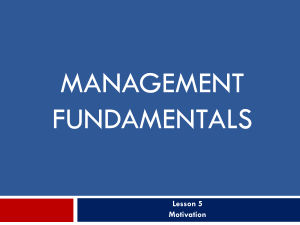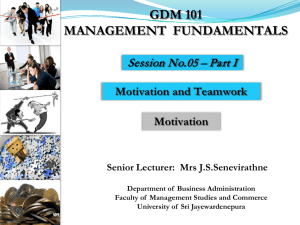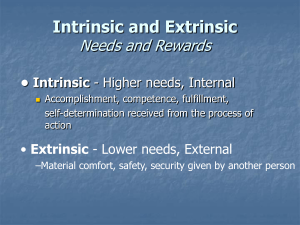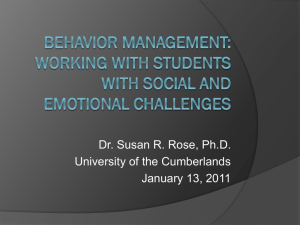T5.Individuals
advertisement
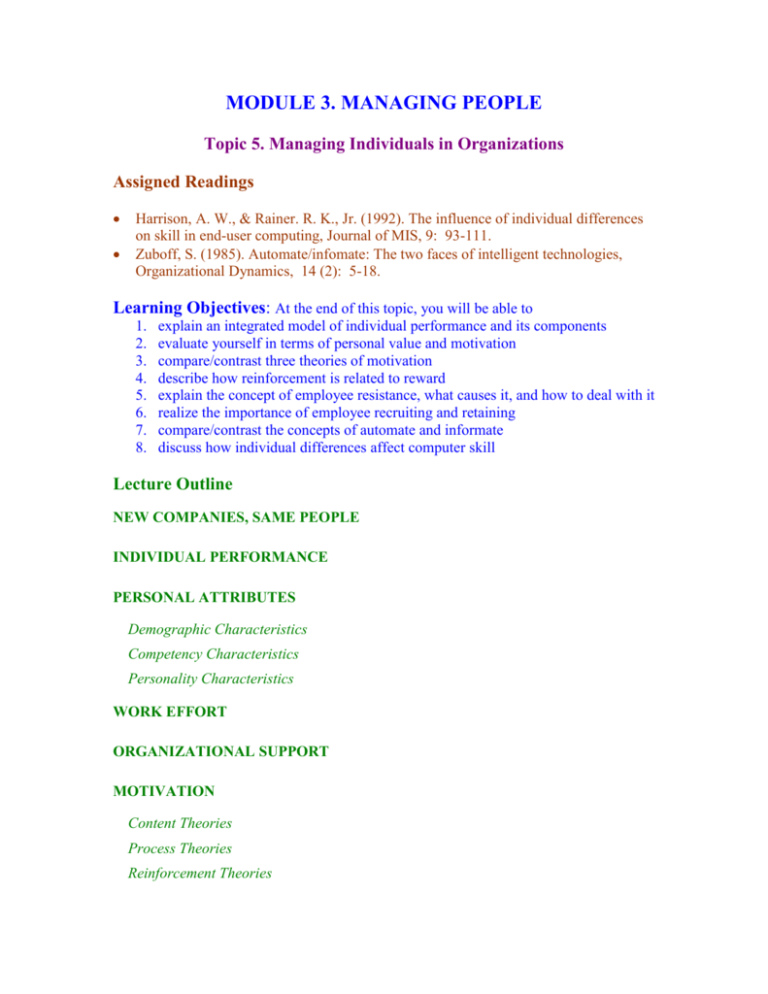
MODULE 3. MANAGING PEOPLE Topic 5. Managing Individuals in Organizations Assigned Readings Harrison, A. W., & Rainer. R. K., Jr. (1992). The influence of individual differences on skill in end-user computing, Journal of MIS, 9: 93-111. Zuboff, S. (1985). Automate/infomate: The two faces of intelligent technologies, Organizational Dynamics, 14 (2): 5-18. Learning Objectives: At the end of this topic, you will be able to 1. 2. 3. 4. 5. 6. 7. 8. explain an integrated model of individual performance and its components evaluate yourself in terms of personal value and motivation compare/contrast three theories of motivation describe how reinforcement is related to reward explain the concept of employee resistance, what causes it, and how to deal with it realize the importance of employee recruiting and retaining compare/contrast the concepts of automate and informate discuss how individual differences affect computer skill Lecture Outline NEW COMPANIES, SAME PEOPLE INDIVIDUAL PERFORMANCE PERSONAL ATTRIBUTES Demographic Characteristics Competency Characteristics Personality Characteristics WORK EFFORT ORGANIZATIONAL SUPPORT MOTIVATION Content Theories Process Theories Reinforcement Theories REINFORCEMENT AND REWARD Employees Resistance Dealing with Employee Resistance Management Challenges: Recruiting and Retaining Employees Readings References Vignette Why Levi Strauss? For years, Levi's was touted in all learned IT quarters as the paragon of what computer technology, intelligently deployed, could do to foster and lead the success charge, even in a relatively unglamorous business like making pants. Mustering all of its IT intelligence and decentralized energies, Levi's attacked a supply-chain problem that sought to slash 80% of the time it took to get a new jean style from the designer's head to the store rack. The pundits roared their approval. However, IT at Levi's seemed to forget something very important along the way to corporate immortality. That "something" is at the heart of the IT role today just as it was 20 years ago and will be tomorrow, too — no matter what you want to think: You are only as good as the quality of usable information you provide to others, those who really run the company. Sure, IT helped build a supply-chain management structure that cut deeply into time-to-market. But at what expense? Turns out, a very high expense. Ditto for the companywide re-engineering, which flushed hundreds of millions of dollars down the consulting sewer with no perceptible return. Where was IT to warn senior managers of the sharply escalating costs, which needed to be judiciously balanced against the real benefits of time-to-market gains and the fuzzier benefit of re-engineering all business processes? More to the point, why didn't IT seek to deploy the right business-intelligence tools that would have alerted senior management to some startling facts about the jeans market? Facts like, kids and teens don't wear the same styles of jeans as their parents. Duh! Here's the killer: It turns out that IT actually did deploy many of those business-intelligence tools and did gather vital information on the market and on internal operations. But IT lacked the persuasiveness, the power, dare I say the credibility — even at that enlightened and progressive company — for its voice to have much impact. There are very real limits to IT in the company. Don't get caught up with all the theater and lights when some of you are turned into superstars on magazine covers. Make the trains run on time — and then just hope the engineer knows where the hell he's going. Source: Laberis, B. 1999. Levi's shows that IT may not be driver it pretends to be. Computerworld, Apr. 12, http://www.computerworld.com/cwi/story/0,1199,NAV47_STO35270,00.html Management of technology is a very difficult and complicate process that involves both the technical and social systems of an organization. Much of the theory and practice of IT management assumes that organizational decisions -- whether technical or social -- are consequences of rational decision making. We assume that managers are rational and collect, evaluate, and apply information in their decision making process. The limitation of traditional ways of thinking is that they fail to account for the human factors that impact technology management (Levine and Rossmoore 1993). NEW COMPANIES, SAME PEOPLE Organizations today are confronting with changes driven by technology, government, customers, suppliers, and global competition. Many companies buy out or merge with others and change their name. For example, in April 2000, Vodafone (NYSE: VOD) is formed by the merger of Bell Atlantic Mobile, AirTouch Cellular, GTE Wireless, PrimeCo Personal Communications and AirTouch Paging; and in July, Verizon Communication (NYSE: VZ) is formed by the merger of Bell Atlantic Corp. and GTE Corp. (McGinity 2001). This name change not only confuses customers but also employees who work in those organizations. Although names may change, managers and employees within the organizations are still the same people. They may not be able to foresee or adapt to change. In fact, there could be a deadly commitment to an obsolete policy or process, or a marginal product or service. The difficulty of adapting to change can lead to resistance and eventually failure of the entire organization. As the human factor continues to be a dominating factor when implementing an information system, Module 3 will focus on managing people including individuals and group. In a typical organizational behavior textbook, a topic of managing individuals spans over many chapters. Although we may not have time to discuss this topic in details since there are other topics need to be covered, we will see issues related to the human factor raised throughout the course. This is because managing people is an critical issue for every manager’s responsibility. People are the heart of an organization, and without people, the organization will not be able to function. We will begin the topic with an integrated model of individual performance summarized from Schermerhorn et al. (1994) INDIVIDUAL PERFORMANCE Individuals are made up an organization. Performance of each individual is a result of his/her personal attributes, work effort spent on a job, and support from the organization. In order to achieve high performance, each of these factors must be present. Performance is maximized when all factors are maximized. Information systems (IS) managers need to understand that individual performance depends on these factors and how they are interact so that they can assign the right task to the right individual. Attributes Capacity to perform Motivation Performance Effort Willingness to perform Support Opportunity to perform Figure 1. An integrated model of individual performance (Schermerhorn et al., 1994). From figure 1, three factors that impacts individual performance are personal attributes, effort, and organizational support. An individual alone controls his/her work effort, while a manager attempts to influence effort through motivation. PERSONAL ATTRIBUTES Personal attributes relate to a capacity to perform. Three major categories lead to individual differences are demographic, competency, and personality. How well individuals perform depends on how well task requirements match their attributes. Therefore, the formula here is Individual attributes Must match Task requirements Job Performance To facilitate Demographic Characteristics Demographic characteristics include ages, gender, disability, marital status, number of children, and experience, which help shape what a person has become. They are easily to identify by simply looking at a person’s appearance or personnel file. These characteristics are important because of three reasons. First, workplace legislation has outlawed against discrimination on basis of personal appearance. Second, performance tends to relate to where and how the person grew up. Third, demographics serve as a basis of stereotypes, which are created when a person is assigned to a group of category (e.g., a blond). This could obscure individual differences. For example, managers may not assign a challenging task to a female with blond hair because most people assume that blond women are not very intelligent. Failure to recognize diversity among workforce could lead to an unfair treat to a certain group of people or placement of wrong people to a wrong task. Competency Characteristics The level of an individual’s competency depends on aptitude and ability of that person. Aptitude is the capability to learn something; ability is the capacity to perform the various tasks needed for a given job. Simply speaking, aptitude refers to an individual’s potential ability, and ability represents skills and expertise that the individual already has. For recruiting and training, aptitude and ability are critical factors. For example, many aptitude and ability tests are designed to test both mental competency (e.g., IQ tests) and physical competency (e.g., ACT, GMAT, and GRE). Individual competency also influences a job assignment and promotion. For example, an employee who passes an Oracle certificate is likely to be assigned to a high-paid job. Personality Characteristics Personality captures the overall profile or combination of characteristics that represent the unique nature of a person and the way he/she interacts with others. Personality is influenced by many factors such as social traits, values and motives, personal conception (i.e., the way a person thinks about his/her social and physical environment), emotional adjustment (i.e., emotional distress), and personality dynamics (i.e., the integration and dynamic organization of the other factors influencing personality). Personality is critical because it tends to relate to the way people behave or act. Managers, for example, need to know how to deal with their subordinates who have different personalities. Read how to deal with difficult people at http://www.civic-strategies.com/library/difficult.pdf WORK EFFORT Assigning a right person to the right task doesn’t guarantee that he/she will perform the task as expected. Willingness to perform is also an important factor that contributes to individual performance. For example, before beginning this class, everyone was asked to take the UCLA online self evaluation quiz to see whether their characters match with an online learner or not. Students who have a high score on the quiz will not necessarily receive a high score at the end of this class. Those who are willing to study and work hard will succeed, while those who are unwilling to participate or don’t turn in assignments will be unlikely to complete the course. ORGANIZATIONAL SUPPORT Without an adequate support from the organization, an employee though is qualified for his/her position and willing to work may not perform well. Researchers refer to such inadequacies as situational constraints that include lack of time; inadequate budgets; inadequate tools, equipment or supplies; unclear instructions or information; unrealistic due date; unfair levels of expected performance; lack of job-related authority; lack of support from coworkers; and inflexibility of procedures (Peters et al. 1985). Many of us may experience some of these situational constraints at work. That’s normal. These constraints are commonly found in every organization. It is important that IS managers must realize that these constraints exist, identify them, and support their subordinates in their areas of responsibility. A sign of failure occurs when the managers know constraints and where they are but still ignore them. Some managers even treat their own employees worse than outsiders. For example, an IS manager of one organization approves a training budget for a new consultant but denies a request from his IS staff to attend the same training class. A second example is when a manager assigns more work to a person who is perceived to be more competence than his/her coworker who has the same title and receive the same pay. MOTIVATION Previous research on motivation can be divided into three schools of thought: content, process, and reinforce theories. Content approaches: What motivates people Process approaches: How they are motivated and Reinforcement approaches: Why they stay that way. Learn more about motivation theories at http://www.oup.co.uk/pdf/bt/fincham/Chapter5.pdf and http://faculty.ssu.edu/~whdecker/buad320/chapter13.ppt Content Theories Content theories (e.g., Maslow, Aldefer, McClellan, and Herzberg) have a lot in common (see figure 2). Individual Needs Attitudes and behavior Tensions activate influence Figure 2. Common concept proposed by content theorists. In general, they suggest that the manager’s job is to create a work environment that responds positively to individuals needs. Poor performance, undesirable behaviors, and unhappiness can be partially explained in terms of “blocked” needs or needs that are unmet on the job. Rewards can be used to activate needs. Content researchers suggest that Understand how individuals differ in what they need from their work Know what can be offered to these individuals in response to their needs Know how to create work settings that give people the opportunity to satisfy their needs by contributing to the task performance of the work unit and the organization Process Theories Unlike content theories that emphasize “what” aspect of motivation, process theories focus on the processes of “why” and “how” people choose one action versus another. Two well-known theories are equity theory and expectancy theory. Equity theory indicates that people compare their rewards (and inputs) with those of others and then become motivated to engage in behavior to enable them to achieve the equity. Feeling inequity may lead to decreased performance or job turnover. Expectancy theory argues that work motivation is determined by an individual’s beliefs concerning effort-performance relationships (expectancy), work-outcome relationship (instrumentality), and the desirability of various work outcomes (valence). Vroom (1964) proposes that Motivation = Expectancy x Instrumentality x Valence. This implies that to maximize motivation, managers must maximize all three aspects of individual concerns. Reinforcement Theories Reinforcements are used to motivate desirable behavior and discourage undesirable behavior. Reinforcement plays a key role in learning process. Learning refers to the process through which an individual acquires new behavior. Understand reinforcement and learning is important for managers who manage a reward system. The Law of Effect states that people learn (or unlearn) behavior based on the consequences that result from that behavior (see Figure 3). http://instruction.bus.wisc.edu/lkuzuhara/mhr300/documents/MHR%20300%20%20Work%20Motivation%20Lecture%20Outline%20(Fall%202001).doc STIMULUS (S) RESPONSE (R) CONSEQUENCE (C) Figure 3. The Operant Conditioning Process 1 1 Note that this is also referred to as the Antecedents (A) - Behavior (B) - Consequences (C) Model. 1. Stimulus - A signal, cue or specific context. 2. Response - The behavior that you want to change. 3. Consequence - Outcomes that occur based on the behavior. For example, when a project deadline is becoming close (stimulus), IS staff stay late at work (response). Thus, they are awarded time off when the project is completed (consequence used to reinforce desirable behavior). Another example is when a client reports a problem to Joey, a technician at a help desk (stimulus), Joey could not solve the problem but didn’t report it to his supervisor (response). A few days later, the customer complained to Joey’s supervisor who later took care of the problem and also had a private meeting with Joey to make sure that he understood his responsibility (consequence used to discourage undesirable behavior). Four types of reinforcement are positive, negative, punishment, and extinction. The above two examples illustrate positive reinforcement and negative reinforcement, respectively. Positive reinforcement should be contingent (administered only if the desired behavior is present) and immediate (awarded right after the desired behavior took place). Negative reinforcement, or avoidance, intends for the person to avoid the negative consequence by performing the desirable behavior. Nagging is a good example of negative reinforcement. However, when nagging doesn’t impact the person, a punishment may be necessary. Unlike positive and negative reinforcement that intends to encourage desirable behavior, punishment and extinction intend to discourage undesirable behavior. Punishment needs to be administered carefully and is likely to be more effective if combined with positive reinforcement. Extinction, the withdrawal of the reinforcing consequences for a given behavior, is needed when someone else tries to cover the other person’s undesirable behavior. For example, Jane hardly participates in a group discussion, but Mary a group leader always complete a task that is assigned to Jane and submit a group paper to an instructor with everyone’s names on the paper. The instructor observes Jane’s behavior and tells Mary to stop covering for Jane. The instructor uses extinction to eliminate undesirable behavior. Once Jane realizes that no one would do a work for her, she begins to participate and contribute to the group REINFORCEMENT AND REWARD Reinforcement based the aforementioned law of effect indicates that behavior will be repeated or eliminated, depending on whether the consequences are positive or negative. Vroom (1964) distinguishes two types of rewards: intrinsic and extrinsic. Extrinsic rewards are positively valued work outcomes that are given to the individual by some other person in the work setting. For example, pay is administered by the upper management in an organization. Intrinsic rewards are positive value work outcomes that are received by the individual directly as a result of task performance. Intrinsic rewards do not require the participation of another person, for example, a feeling of accomplishment. Reinforcement is related to extrinsic rewards because these rewards serve as environmental consequences that an influence people’s work behavior through the law of effect. As mentioned earlier in the integrated model of individual performance, managers attempt to promote individual satisfaction (or job satisfaction) through motivation (either intrinsic or extrinsic reward). Schermerhorn et al. (1994) point out, "when rewards are allocated on the basis of past performance (i.e., when rewards are performancecontingent), they can cause both future performance and satisfaction. For managers, this means that they need to create a work setting that positively responds to individual needs and goals. Employees will be motivated or not depending on the availability and equity of rewards, both intrinsic and extrinsic. Therefore, an extended model of individual performance and satisfaction can be seen in figure 4. Notice the feedback lines from rewards and satisfaction to motivation (green arrows). That means that rewards and satisfaction also drive motivation. Attributes Motivation Effort Performance Support Extrinsic Rewards Satisfaction Intrinsic Rewards Equity compensation Figure 4. Relationship among Motivation, Performance, Rewards, and Satisfaction EMPLOYEES RESISTANCE More often, change is almost always perceived by employees as a threat, even if the existing situation is considered unsatisfactory. Pendlebury et al. (1998) say, " The transformation from seeing change as a threatening phenomenon to seeing it as one offering opportunities is an essential element in making a success of change, because without this transformation employees will resist change, through fear of suffering its negative consequences, and will disguise its positive aspects." They further suggest that a positive mentality needs to be developed at the beginning of the change process and reinforced constantly throughout the process. To begin with, we need to understand 7 common causes of resistance (Pendlebury et al. 1998). Lack of Awareness: Employees are not aware of existing problems and satisfied with the current situation. They do not understand why things need to be change. Similar to the old cliché "if it ain't broke, don't fix it." Relegation: Employees refuse to delegate themselves to the change process that they think does not solve (what they think to be) a real problem. This type of thinking, perhaps, is caused by a poor understanding of the priorities of the business. Lack of Familiarity: Employees are not familiar with or do not understand the solution, and that is why they resist. An unclear definition of the vision or poor communication from top management is usually the reason for this resistance. Rejection of the Solution: The problem is recognized and the solution is known, but employees reject the solution because they don't think it is appropriate. This resistance could cause by two reasons. If it were due to lack of knowledge of the process, it would not be difficult to overcome by explaining to them the solution. On the contrary, if the resistance occurs because the solution is contradicted to the staff's experience, management needs to reconsider the issue. Although it is a good choice, the staff may not cooperate to implement it. Fear of the Consequences: The staff are afraid of not being able to adapt to the new conditions or of losing advantages or power. Handling emotional and power issues is one of the most difficult tasks in change management. The Means: The means to conduct the change is not considered appropriate in terms of its timetable or cost. This leads to resistance to change because people think that the means made available are not conductive to its success, or because they do not feel that management really considers it a priority. Lack of Interest: Some people are concerned with neither a problem, solution, nor means. The term 'change' is equal to 'work' and requires energy. This attitude is stemmed from lack of interest in their job, skepticism, or frustration with the decision to implement change. DEALING WITH EMPLOYEE RESISTANCE Moorhead and Griffin (1995) recommend five techniques to dealing with employee resistance. According to the view of considering an organization as a social system, these techniques intend to influence the elements of the social system to help reduce resistance from employees. These five techniques are as follow. Take a Holistic View: A holistic view of the organization encompasses the culture and dominant coalition as well as the people, structure, tasks, and information subsystems. Since each of these subsystems are interdependent, addressing one while ignoring the other can cause a chaos during transforming the organization. Taking a holistic view allows managers to anticipate effects the social system and culture in their organization. Top Management Support: Top management plays a critical role in successful change management. Gaining commitment from senior executives is significant because resource allocation to pursue change efforts must be approved by them. They can also help persuade everyone in the organization to participate in the process of change. Encourage Participation: Allowing employees to participate in planning the change is one way to reduce resistance. Creating a sense of ownership and giving the decision power may help win their support during implementation. Forster Open Communication: During transition, open communication plays a role of managing resistance to change and overcoming information and control problems. Without information flowing top-down and bottom-up, employees may have to guess or listen to rumors, which may endanger the change process. Managers must be open their communication with their subordinates no matter what a news is good or bad. Reward Contributors: Employees who contribute to the change in any way need to be rewarded financially and non-financially (i.e., a mention in a news release or an internal memo). From a behavioral standpoint, individuals expect benefits in return if they help the company change the way it does the business. Their efforts must be recognized; otherwise they may not appreciate and decide to leave the company. Rewarding needs to be done appropriately so it does not create enemies among co-workers. The aforementioned five keys to managing employee resistance can be used as guidelines to manage organizational behavior. Operating under a turbulent and dynamic environment, today managers must anticipate the need for change and satisfy it with responsive and competitive organization systems. As they need commitment from their employees, they are facing a difficult task of recruiting and retaining them, especially IT staff due to a popular IT job market. MANAGEMENT CHALLENGES: RECRUITING AND RETAINING EMPLOYEES According to the Dotcom advisor, today corporations may want to hire back their employees who went into a dotcom business when it was boom. Read the story below. "Boomerang" Employees Many dot com companies have laid off employees or closed down entirely because of the stock market's fall. This is a great opportunity for traditional companies to find scarce IT staff by re-hiring employees they lost to dot com startups. Use this unique opportunity to greatly enhance your IT department's capabilities by re-hiring "boomerang" employees. How This Saves Money Hire technology workers already familiar with your company who can now bring valuable e-commerce experience to your projects. Action Plan To re-hire former IT staff who worked at a failed dot com company, get your IT manager to do the following: 1. Conduct exit interviews when employees leave to learn why they are leaving and whether they would be good boomerang employee candidates. 2. Make a list of employees you have recently lost to dot com startups or other companies. 3. Find out where they are working by asking their friends still working at your company. 4. Use their employment history records and their new dot com responsibilities to decide which former employees are good candidates for being re-hired and which are not. Make sure you check your employment records for problems like insubordination, poor communication skills, or other issues that would make them bad candidates for re-hiring. 5. Contact the candidates you are interested in directly or indirectly through friends. See if their long term career plans fit with your company's. 6. Try to give these people new responsibilities instead of their old jobs. This is less likely to be seen by other employees as rewarding disloyal behavior. 7. Consider creating an employee alumni program with newsletters and social events. This is a great way to increase loyalty to the company and encourage informal communication that will ease hiring later. READINGS There are two assigned readings for this topic. Zuboff's article (1985) is a classical one. Zuboff coins a term "informate", which is well known among IS researchers. She argues that technology is often used to automate a process and help reduce skill and labor requirements. However, technology has more potential to provide information for an organization to gain a competitive advantage. Zuboff mentions, "An information strategy requires a comprehensive vision that appreciates the unique capacities of intelligent technology and recognizes the need to use the organization to liberate those capabilities." Moreover, an "informated" organization will have to rely on the human capacities for teaching and learning, criticism, and insight. Harrison and Rainer (1992) conducted a survey collecting data from knowledge workers to identify the influence of individual differences on computer skills. Several individual differences variable include gender, age, experience with computers, attitude of confidence regarding computers, math anxiety, and a creative cognitive learning style. They found that creative young males who have more experience and confidence with computers and lower math anxiety have higher computer skills. They suggest that organizations should manage end user computing using two complementary processes: a global and individual process. REFERENCES Janis, I.L. 1982. Groupthink, 2nd ed. Houghton Mifflin: Boston, p. 9. Levine, H.G. and Rossmoore, D. 1993. Diagnosing the Human Threats to Information Technology Implementation: A Missing Factor in Systems Analysis Illustrated in a Case Study, Journal of MIS, 10(2), Fall, p. 55-73. McGinity, M. 2001. Name is the Game. Communication of the ACM, 44(2), February, p. 21-23. Moorhead, G. and Griffin, R.W. 1995. Organizational Behavior, Houghton Mifflin Co.: Boston. Pendlebury, J; Grouard, B.; and Meston, F. 1998. The Ten Keys to Successful Change Management. John Wiley & Sons, New York, NY. Peters, L.H., O’Connor, E.J., Eulberg, J.R. (1985). Situational constraints: Sources, consequences, and future considerations. In Kendreth M. Rowland and Gerald R. Ferris, eds. Research in Personnel and Human Resource Management, Vol. 3, Greenwich, CT: JAI Press. Schermerhorn, J.R. Jr., Hunt, J.G., and Osborn, R.N. (1994). Managing Organizational Behavior, 5th ed, New York, NY: John Wiley & Sons, Inc. Vroom, V.H. (1964). Work and Motivation. New York: John Wiley & sons.



